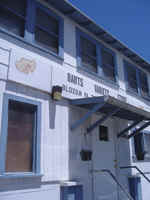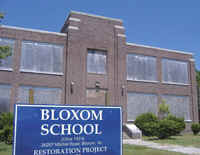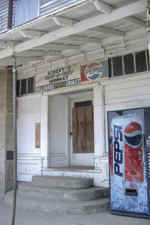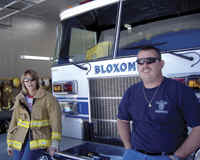
Download
in PDF Format
If you�re looking for fancy
festivals, posh parades, or high-brow celebrations of any kind, bypass
Bloxom. The tiny Eastern Shore hamlet, population 406, has none of these.
If you�re looking for a bustling
town with swanky caf�s, artsy gift shops and museums, keep on goin�. If,
however, you�re looking for a slice of railroad history, faded and a bit
tattered around the edges, and a place lovingly called home, Bloxom can
deliver. �We�re just a nice, quiet little town,� says Ronnie
Williams, a 40-year resident and a town council member. �We don�t have
much goin� on around here.�
|

Bloxom's
main street is only a shadow of its former self. The post office
is probably the busiest place in town. Both buildings to the post
office's left were formerly businesses, but are now used as rental
apartments. |
While that may be true now, Bloxom�s
rich history tells another story.
In 1884, when the railroad first
iron-stitched its way down the length of the Eastern Shore, the seeds of
many a small town were planted. Because the railroad�s corridor
sidestepped bigger towns, stations were established every 3-4 miles.
Bloxom was one of those.
The town�s Railroad Square rose from
land rented for $1 to the railroad �for the sole purpose of freight and
rail passenger service only,� says the original deed. Businesses
blossomed around it. When a post office was built, railroad authorities
named the town after its first postmaster, William E. Bloxom.
By the turn of the century, the
business district included an undertaker and wheelwright, a restaurant, a
general store, a brick kiln, a hotel and five bars, which �suffered when
the Commonwealth of Virginia made liquor by the drink illegal in 1918,�
according to Eastern Shore author and historian Arthur King Fisher.
|

Bloxom
is filled with farmhouses, Victorians, and wonderful bungalows. |
On weekdays in Bloxom, the trains
brought produce buyers who bid on a variety of potatoes, green beans,
strawberries and other crops at the square�s auction block. When they
had bought enough produce to ship, the buyers either bundled them directly
on the train or sent the potatoes to nearby barrel makers to be packaged.
Later, the barrel makers would be
replaced by grating sheds where the potatoes would be cleaned, sorted by
size and placed in sacks. The iron horse also brought preachers and
churches looking for congregations and converts. Several denominations,
including the Methodists, Presbyterians and Episcopalians, founded
churches in Bloxom as early as the 1890s.
Sixty-eight-year-old Gene Godwin and
his brother Ralph moved to Bloxom as children with their father, a
|

On
the town's main drag, neglected or abandoned buildings stand
alongside thriving mom-and-pop businesses. |
Pennsylvania Railroad Express agent
whose duties included preparing shipping invoices and sealing the heavily
loaded rail cars.
During Christmas holidays, local
families would make holly wreaths and ship them to New York and
Philadelphia for sale, remembers lifelong local John Somers. �Believe
you me,� says 68-year-old Somers, �We were a thriving community. We
had a lot of stores on both sides of the track.�
During Bloxom�s heyday in the late
1930s and throughout the �40s, the town would boast a doctor�s office,
a barbershop, a hardware-and-feed store, two banks, a grocery store and
more. Elegant Victorians with wide, yawning porches, tidy bungalows and
comfortable farmhouses encircled the town�s business district.
|

Bloxom
School was closed in 1998 and has been vacant ever since. Harlan
and Jan York from Delaware recently bought the building and plan
on restoring it into a showcase home. |
In 1931, the town celebrated the
opening of its own school, a two-story, brick building erected according
to state plans, much like what can be found in many a small Virginia town.
Bloxom incorporated in 1952. Four years later, Bloxom Volunteer Fire
Company was founded and a station was dedicated.
Throughout it all, the town�s siren
song was the whistle of the train as it skated into town.
After World War II, however, the train
found itself in a dead-heat race for survival with the automobile. Just as
the four-legged horse yielded to the iron horse years earlier, the iron
horse was about to submit to the motorized one. Its submission would shape
the course of railroad towns
like Bloxom.
During World War II, the railroad was
loading almost 1,000 freight cars a day. A decade later, freight-car
business was down by more than 50 percent. By the end of the 1950s,
freight and passenger business had deteriorated so dramatically that
passenger service was discontinued altogether around 1960.
|

On
the town's main drag, neglected or abandoned buildings stand
alongside thriving mom-and-pop businesses. |
As the country�s economy continued
to recover from the Depression and the war, highways were being built and
improved, and the car and the truck proved to be the preferred modes of
transportation. Today, the train only passes through
Bloxom on its way to somewhere else and the town is a shadow of its former
self.
The auction block is long gone, the
decrepit freight station was burned by the town sometime in the 1980s, and
Bloxom�s train station, sold, dismantled and moved, now graces the
tracks in Cape Charles, a town almost an hour south.
A walk down Shoremain Drive,
Bloxom�s version of Main Street, reveals a hodgepodge of thriving
mom-and-pop businesses and a good number of neglected or abandoned
buildings. Judy�s Flower Shop sits vine-choked and empty just down the
road from the busy and crisply modern Greenbush Automotive, owned by
Trower Bell. The post office is sandwiched between a good-looking town
hall and two forlorn brick buildings. Hart�s Variety Store faces the
town�s old general store, whose sagging and paint-chipped porch is now
used as a gathering spot for some of the town�s retired menfolk.
|

A
mainstay of Bloxom is the secondhand and antique store called
Bloxom's A to Z. |
By the looks of it, Bloxom�s post
office is probably the busiest place around, mainly because it services
other towns, such as nearby Macedonia and Modest Town, in addition to
Bloxom. Nancy Neal, postmaster for the last 16 years, maintains 423 rented
boxes and 415 routes that run from bayside to seaside.
On Mitchel Road, Bloxom School sits
boarded up and silent. Over the years, the county systematically whittled
the school down from a K-12
school to an elementary school to a primary school. In 1998, its doors
were permanently closed when the county consolidated schools.
�It used to be a nice place with
lots of children running out here,� says Mason Durham, who for 23 years
commuted across the street from his home to work as the school�s
custodian. He points to the ball field waist-high in weeds and
wildflowers. �When they closed the school, it just hurt the town.�
|

Kimberly
Midgett, 10-year veteran, and Sean Bagwell, deputy chief, are part
of Bloxom's 65-member colunteer fire company. The company suffered
a serious blow in January when their opwn station was gutted by
flames while they were out on another call. |
The latest blow to the town occurred
in January. While its volunteers were out on another call, Bloxom�s
volunteer fire station was gutted by flames. A large group of townsfolk,
helpless to do anything, stood on the railroad tracks in the brisk night
air and wept. The next day the roof collapsed.
�Many members didn�t leave the
site for 48 hours,� says Deputy Chief Sean Bagwell, whose grandfather
helped build the original station and whose brother, Jody, is the current
fire chief. Defiant, one member hauled the original
pull-cart fire engine, scorched and seared, outside the building and stuck
a flag in it. �Just to say we were still here,� adds Kimberly Midgett,
a 10-year veteran of the station.
Since that night, support from the
town and the entire county has been overwhelming. The fire company was
lent a pole barn, which was enclosed, equipped with electricity and
plumbing, to house the company�s fire engines. Donations and community
fundraisers are paving the road to rebuilding, which should cost about
$1.5 million. The fire company�s gallant resurrection from the ashes,
marked by the flag in the pull-cart, seems to symbolize a change of
direction for the town.
A police station is currently under
construction for its newly created full-time police officer position. Once
completed, it will also act as temporary office space and shelter for the
fire company�s ambulances. Bloxom School is also
about to experience a revival. Jan and Gil York, antique dealers from
Delaware, have recently purchased the over-10,000-square-foot school and
intend to renovate it into a grand home with formal gardens. �It�ll be
a showplace. That�s our objective,� says Gil. �Someday you might get
to see it on TV, but that�s a year or two down the road.�
Citing the boom that has taken place
in the nearby town of Parksley, the Yorks think Bloxom is a find.
�[Bloxom] is a diamond in the rough,� says Gil. �It has tremendous
potential.�
That�s no secret to Bloxom�s
long-timers, people like John Somers and Louella Parks Fox, who operated a
beauty shop next door to the post office for almost 30 years and whose
first husband, the late Ben Parks, was a founding member of the fire
company. They have loved this town in good times and bad, in sickness and
in health. They know Bloxom�s potential because they have seen it
realized. They have lived it. �Bloxom has been my town,� says Somers.
�I love this town, always have. And if the Lord is willing, I�ll die
here.�